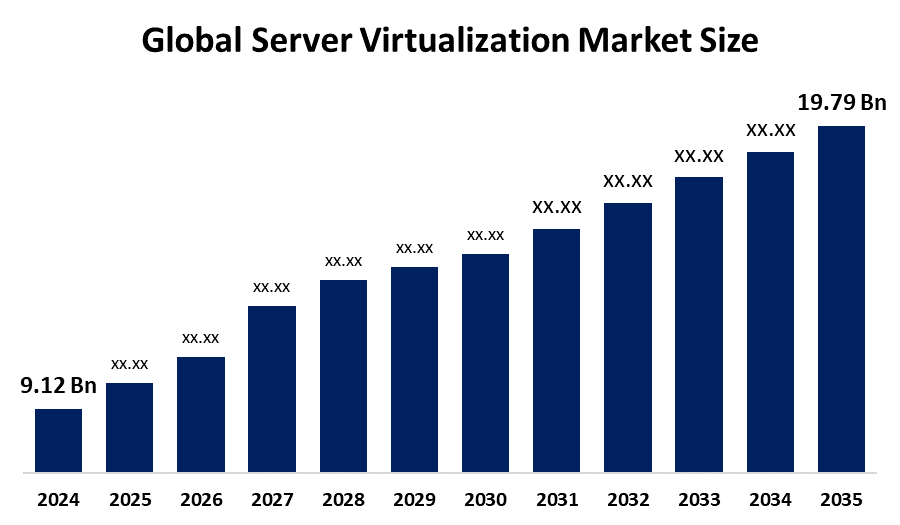Global Server Virtualization Market Insights Forecasts to 2035
- The Global Server Virtualization Market Size Was Estimated at USD 9.12 Billion in 2024
- The Market Size is Expected to Grow at a CAGR of around 7.3% from 2025 to 2035
- The Worldwide Server Virtualization Market Size is Expected to Reach USD 19.79 Billion by 2035
- Asia Pacific is expected to grow the fastest during the forecast period.

Server Virtualization Market
The Global Server Virtualization Market Size involves the use of technology to create multiple virtual servers on a single physical server. This process allows different operating systems and applications to run independently on the same hardware, maximizing resource utilization and minimizing the need for additional physical servers. Server virtualization simplifies IT infrastructure by enabling easier management, improved scalability, and enhanced flexibility. It helps organizations reduce costs related to hardware, power, and cooling while improving disaster recovery and business continuity. Various virtualization types include hardware virtualization, software virtualization, and storage virtualization, each serving different operational needs. The market features a range of solutions from leading companies like VMware, Microsoft, and Citrix, providing platforms tailored for enterprises of varying sizes. As digital transformation accelerates, server virtualization remains essential for optimizing data center performance and supporting cloud environments. Overall, server virtualization is a fundamental technology reshaping modern IT infrastructure by enabling efficient, flexible, and cost-effective server management.
Attractive Opportunities in the Server Virtualization Market
- Server virtualization combined with AI and machine learning can optimize resource allocation and automate management tasks, leading to smarter, more efficient IT infrastructure. This synergy opens up new avenues for innovation and enhanced operational efficiency.
- Virtualization enables efficient processing closer to data sources in edge computing environments, reducing latency and bandwidth usage. As edge computing grows, especially with IoT and 5G adoption, virtualization plays a key role in enabling faster, scalable, and flexible processing at the network edge.
Global Server Virtualization Market Dynamics
DRIVER: Organizations are seeking ways to consolidate their server infrastructure to lower capital and operational expenses
The growth of the global server virtualization market is primarily fueled by the increasing need for efficient utilization of IT resources and cost reduction. Organizations are seeking ways to consolidate their server infrastructure to lower capital and operational expenses, making virtualization an attractive solution. The rise of cloud computing and the shift toward hybrid and multi-cloud environments further drive adoption, as virtualization enables seamless workload mobility and management across diverse platforms. Additionally, the growing demand for improved disaster recovery and business continuity solutions encourages businesses to adopt virtualization technologies. Advances in virtualization software and hardware, such as improved security features and support for containers, also contribute to market expansion. The surge in data generation and the need for scalable IT infrastructure in sectors like healthcare, finance, and retail push companies to invest in virtualization. Overall, these factors combine to accelerate the adoption and development of server virtualization, supporting digital transformation initiatives worldwide.
RESTRAINT: Complexity involved in migrating from traditional physical servers to virtualized environments
Despite its advantages, the global server virtualization market faces several restraining factors. One major challenge is the complexity involved in migrating from traditional physical servers to virtualized environments, which can require significant time, expertise, and financial investment. Security concerns also pose a barrier, as virtualized systems can be vulnerable to cyberattacks, data breaches, and unauthorized access if not properly managed. Additionally, performance overhead caused by virtualization layers may impact critical applications that require high-speed processing or low latency. Organizations with legacy systems or limited IT infrastructure may find it difficult to implement virtualization effectively. Furthermore, managing and maintaining virtual environments can become complex as the number of virtual machines increases, leading to potential operational inefficiencies. Lastly, the initial setup costs and licensing fees for virtualization software can be high, especially for small and medium-sized businesses, which may limit widespread adoption in certain market segments. These factors collectively restrain the rapid growth of the server virtualization market.
OPPORTUNITY: Growing focus on green IT and sustainability encourages businesses
One significant opportunity lies in the integration of virtualization with emerging technologies like artificial intelligence (AI) and machine learning, which can optimize resource allocation and automate management tasks. Another is the expansion of edge computing, where virtualization can enable efficient processing closer to data sources, reducing latency and bandwidth usage. The increasing adoption of containerization alongside virtualization presents opportunities for hybrid solutions that combine flexibility with efficiency. Additionally, the growing focus on green IT and sustainability encourages businesses to adopt virtualization to reduce energy consumption and carbon footprints. Opportunities also exist in developing specialized virtualization solutions tailored for industries with specific compliance and security needs, such as healthcare and finance. Lastly, the rise of 5G networks creates new possibilities for virtualized network functions, enhancing performance and scalability in telecommunications. These emerging trends and niches provide fresh avenues for innovation and market expansion in server virtualization.
CHALLENGES: Ensuring seamless compatibility between diverse virtualization platforms and legacy systems
The server virtualization market faces unique challenges such as ensuring seamless compatibility between diverse virtualization platforms and legacy systems. Managing performance in complex virtual environments requires advanced monitoring tools. There is also a shortage of skilled professionals knowledgeable in both virtualization and infrastructure. Regulatory compliance adds pressure to constantly update security and data protection measures. Additionally, uncontrolled growth of virtual machines, known as virtual sprawl, can lead to inefficiencies and higher costs. Rapid tech changes force frequent upgrades, straining budgets and resources. Overcoming these challenges is crucial to fully leverage virtualization’s benefits while maintaining control and efficiency.
Global Server Virtualization Market Ecosystem Analysis
The Global Server Virtualization Market Size ecosystem includes technology providers like VMware and Microsoft who develop virtualization software, along with hardware manufacturers supplying servers and storage. Cloud service providers offer virtualization as part of their services, while system integrators and managed service providers support deployment and management. End-users across industries such as healthcare, finance, and IT drive demand. Regulatory bodies set compliance standards, and security vendors provide protection tools. Together, these stakeholders create a dynamic ecosystem that fosters innovation and widespread adoption of server virtualization.
Based on the component, the software segment accounted for the leading market revenue share over the forecast period
The software segment dominance is due to the critical role virtualization software plays in enabling efficient resource allocation, management, and scalability across physical servers. Software solutions from key providers offer advanced features such as automation, security, and compatibility with diverse IT environments, driving widespread adoption. As businesses increasingly prioritize digital transformation and cloud integration, demand for robust virtualization software continues to grow, solidifying its leading position in the market revenue share.
Based on the type, the full virtualization segment accounted for the largest market revenue share during the forecast period

Full virtualization allows complete abstraction of the underlying hardware, enabling multiple operating systems to run independently on a single physical server without modification. This flexibility, combined with improved resource utilization and strong isolation between virtual machines, makes it highly attractive for businesses. As a result, full virtualization remains the preferred choice for enterprises seeking efficient, scalable, and secure server environments, driving its dominant revenue share in the market.
North America is anticipated to hold the largest market share of the server virtualization market during the forecast period
North America is anticipated to hold the largest market share in the server virtualization market during the forecast period. This is driven by the region’s advanced IT infrastructure, high adoption of cloud computing, and presence of major technology companies. Additionally, strong investments in digital transformation and data center modernization fuel demand for virtualization solutions. Enterprises in North America prioritize efficiency, scalability, and cost savings, making server virtualization a key strategy. These factors collectively contribute to the region’s dominant position in the global server virtualization market.
Asia Pacific is expected to grow at the fastest CAGR in the server virtualization market during the forecast period
Asia Pacific is expected to grow at the fastest CAGR in the server virtualization market during the forecast period. This rapid growth is driven by increasing digital transformation initiatives, expanding IT infrastructure, and rising adoption of cloud services in emerging economies like India and China. Additionally, growing investments in data centers and the proliferation of small and medium-sized enterprises seeking cost-effective virtualization solutions contribute to the region’s dynamic market expansion. These factors position Asia Pacific as the fastest-growing market in the server virtualization industry.
Recent Development
- In February 2024, VMware introduced vSphere 8, a comprehensive server virtualization platform designed to enhance performance, scalability, and security for modern workloads. This release enables organizations to efficiently manage and optimize their IT infrastructure, supporting the growing demands of cloud computing and hybrid environments.
- In March 2024, SteelDome Cyber LLC launched StratiSERV, an enterprise virtualization hypervisor and management platform. StratiSERV offers unparalleled flexibility, scalability, and performance, either independently or alongside SteelDome's enterprise storage platform, StratiSTOR, giving customers comprehensive control and adaptability over their infrastructure.
Key Market Players
KEY PLAYERS IN THE SERVER VIRTUALIZATION MARKET INCLUDE
- VMware, Inc.
- Microsoft Corporation
- Citrix Systems, Inc.
- Oracle Corporation
- Red Hat, Inc.
- Nutanix, Inc.
- IBM Corporation
- Dell Technologies
- Huawei Technologies Co., Ltd.
- Oracle VM
Market Segment
This study forecasts revenue at global, regional, and country levels from 2020 to 2035. Spherical Insights has segmented the server virtualization market based on the below-mentioned segments:
Global Server Virtualization Market, By Component
Global Server Virtualization Market, By Type
- Full Virtualization
- Para-virtualization
- OS-level Virtualization
Global Server Virtualization Market, By Regional Analysis
- North America
- Europe
- Germany
- UK
- France
- Italy
- Spain
- Russia
- Rest of Europe
- Asia Pacific
- China
- Japan
- India
- South Korea
- Australia
- Rest of Asia Pacific
- South America
- Brazil
- Argentina
- Rest of South America
- Middle East & Africa
- UAE
- Saudi Arabia
- Qatar
- South Africa
- Rest of the Middle East & Africa





